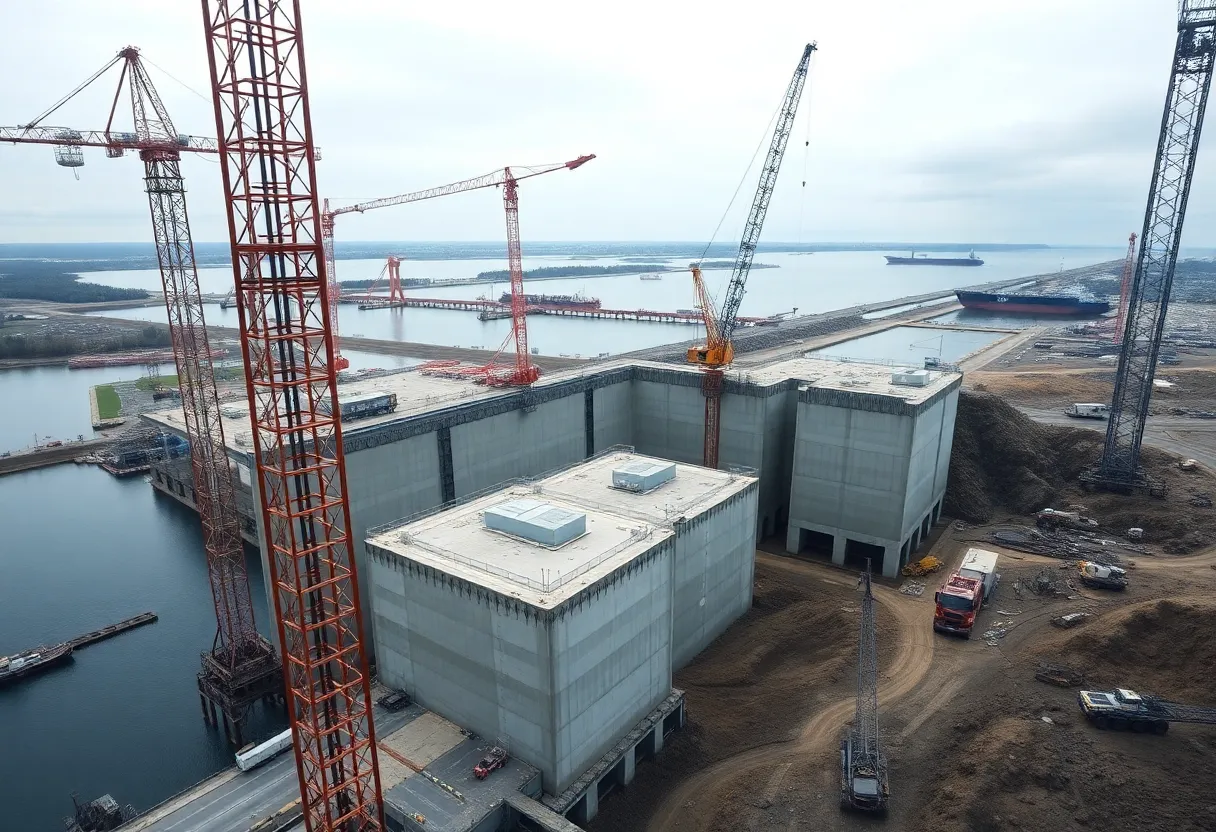Sault Ste. Marie, Michigan, September 15, 2025
News Summary
The U.S. Army Corps of Engineers revised the certified cost estimate for the new Soo Locks large lock from nearly $3.0 billion to about $2.62 billion after awarding all contract options and removing contingency tied to unawarded sub‑phases, trimming roughly $250 million of project risk. Construction remains on track for a scheduled summer completion. Reported federal funding totals vary above $2.2 billion, and managers cite a near‑term need of about $103 million to keep work moving. Phase three work is under way with bedrock excavation, monolith placement and three tall tower cranes on site.
Army Corps Revises Soo Locks New-Lock Cost Down to ~$2.62B; Construction Remains on Track for Summer 2030
The latest certified cost estimate for the Soo Locks new-lock project in Sault Ste. Marie was revised from nearly $3.0 billion to about $2.62 billion, a reduction of roughly 13%, according to the U.S. Army Corps of Engineers. The update was disclosed during a stakeholder presentation on a Thursday. Officials emphasized the project remains on track for completion in the summer of 2030.
Experts attributed the downward revision to the elimination of contingency costs tied to different sub‑phases of the contracts after all nine options were awarded. Kevin McDaniels, Deputy District Engineer for Planning Programs and Project Management for the Detroit District, said awarding all nine contracts on time allowed the removal of essentially $250 million in risk to the project. The Corps noted that the timely awards helped stabilize the overall cost outlook.
Funding figures circulated in multiple reports show two close but distinct totals to date: one reporting $2.321 billion in funding to date, and another listing $2.231 billion. Both figures appear in the project’s coverage and reflect variations across sources cited by observers. In parallel, President Donald Trump’s 2026 budget proposal included $176 million for the project, and Army Corps officials say about $103 million will be needed to push construction forward in the 2027 fiscal year.
The design calls for a new lock 1,200 feet long to mirror the existing Poe Lock. The Poe Lock is currently the only lock in the complex large enough to handle the largest Great Lakes freighters that carry about 88% of the tonnage moving between Lakes Superior and Huron, underscoring the lock system’s critical role in the region’s economy.
The Soo Locks shipping complex is a linchpin of the U.S. steel supply chain, moving iron ore from Lake Superior to mills on the lower Great Lakes for processing into high‑strength steel. Government estimates warn that an unscheduled Poe Lock outage could trigger significant economic consequences, highlighting the importance of maintaining redundancy in the system.
The project sits in its third phase; earlier phases included upstream approach-wall work and deepening the upstream channel to 30 feet. The current phase focuses on building the new lock chamber. The third‑phase construction contract was awarded in July for approximately $1.068 billion, with timelines suggesting a multi‑year effort. Different sources place the duration of Phase 3 at roughly six to seven years.
Construction progress includes substantial site transformation: downstream approach walls on the new lock site, a new bridge to the existing power plant, and installation of a new pump. The project has completed more than $630 million of work to date according to one tally, with another figure placing completed work at about $543 million through the end of February 2025. Milestones reached in the recent period include the completion of a new bridge to the power plant, demolition of the Sabin Lock structure, filling in the Davis Lock footprint to grade with bedrock and construction debris, and the installation of the final tower crane on site.
The third and final tower crane—between 240 and 270 feet tall—shifts material handling across the site and is believed to be among the tallest structures in Michigan’s Upper Peninsula. Army Corps staff note these may be the first tower cranes ever erected in Sault Ste. Marie and potentially the first in the Upper Peninsula. A ship‑simulation study conducted in Vicksburg, Mississippi, helped validate approaches and led to adjustments such as lengthening the north upstream approach wall and adding timber fenders on the south upstream approach wall to cushion vessels against the walls.
Bedrock excavation for the new lock remains a major contractor focus, with bedrock being fractured using hydraulic “hoe rams” to prepare foundations for the lock walls. The lock walls are being built as a series of monoliths, with a plan for eighty‑one monoliths on the north and south sides of the chamber. To date, just over half of the monoliths have been started, and one has been completed. The concrete mix used for the monoliths is unusually stiff, featuring heavy 2‑ to 3‑inch aggregate, and crews have techniques such as wearing snow shoes to walk on the surface as it cures.
The project’s timeline reflects the complex logistics of working through winter months and across navigation channels and two active locks, MacArthur and Poe. A 2015 Homeland Security study that helped drive the 2018 reauthorization cited potential GDP impacts from a Poe Lock outage, reinforcing why project planners emphasize resilience and redundancy. The work plan envisions reconfiguring the Sabin and Davis locks into a single large chamber similar to the Poe Lock over the next several years.
The project’s authorized cost has evolved since its inception in 1986. It was reauthorized in 2018 under WRDA for up to $922 million, and later WRDA actions raised the authorized total to $3.219 billion due to evolving conditions such as labor shortages, supply chain disruptions, and material cost increases. Federal funding streams include nearly $479 million from the Bipartisan Infrastructure Law, $480 million from the 2022 budget, and substantial annual appropriations in 2020 and 2021. In late 2022, Congress reauthorized the project at the higher level, tying the schedule to the WRDA framework. Public affairs officials stress that securing funding at a larger scale remains a challenge that can influence the timetable, even as project leaders assert progress toward completion within the revised budget.
Industry and lawmakers have voiced a mix of concern and support. Some officials describe the cost projections as disappointing but stress the project’s essential role in maintaining a reliable North American steel supply chain. The new lock will provide a second Poe‑sized facility, enabling continued ore movements if the Poe Lock is temporarily unavailable. The design also includes hands‑free mooring features and other innovations intended to improve safety and efficiency for ship traffic as water levels fluctuate.
Frequently Asked Questions
- What is the primary purpose of the Soo Locks project?
- The project adds a second large lock to mirror the Poe Lock, creating redundancy and capacity to keep Great Lakes ore and related traffic moving even during maintenance or outages at any single lock.
- What is the current estimated cost of the new lock?
- The latest certified estimate places the cost at approximately $2.62 billion, reflecting a reduction from an earlier figure near $3.0 billion.
- When is completion expected?
- Officials say the project is on track for completion in the summer of 2030, with Phase 3 work spanning multiple years and continuing next steps into the late 2020s.
- What are the major phases of the project?
- Phase 1 deepened the upstream channel to 30 feet; Phase 2 rehabilitated upstream approach walls; Phase 3 constructs the new lock chamber and rehabilitates downstream walls along with related work.
- How is the project being funded?
- Funding comes from multiple streams, including WRDA reauthorizations, the Bipartisan Infrastructure Law, and annual appropriations. The authorized cost has increased over time due to inflation and supply chain factors, but progress continues within the updated budget.
- What are some notable construction milestones recently completed?
- Recent milestones include the completion of a new bridge to the power plant, demolition of the Sabin Lock, filling the Davis Lock footprint to grade, and the installation of the final tower crane, among other site transformations.
- Why is there emphasis on bedrock and monoliths?
- Bedrock excavation provides a solid foundation for the new lock walls, which are being built as monoliths to create robust, modular walls that can withstand heavy ship traffic and water pressure.
- What impact could delays have on costs or schedule?
- Analyses indicate market conditions, inflation, and labor costs can affect the project’s cost trajectory and schedule, prompting ongoing cost estimates and potential reauthorization considerations.
Key Features of the Soo Locks New-Lock Project
| Feature | Details |
|---|---|
| Lock length and dimensions | New lock planned to be 1,200 feet long to mirror the Poe Lock (1,200 feet by 110 feet). |
| Current cost estimate | Revised to approximately $2.62 billion, a ~13% decrease from ~$3.0 billion. |
| Funding to date | Reported amounts include $2.321 billion and $2.231 billion across different sources. |
| Completion target | On track for summer 2030 completion. |
| Phase breakdown | Phase 1: upstream channel deepening; Phase 2: upstream wall rehabilitation; Phase 3: new lock chamber construction and downstream wall rehabilitation. |
| Major milestones completed | Bridge to power plant; Sabin Lock demolition; Davis Lock footprint filled to grade; final tower crane installed. |
| Key design features | Monolithic lock walls formed from 81 planned monoliths; timber fenders added after ship-simulation review; bedrock foundations prepared for lock walls. |
| Expected economic impact considerations | Second large lock provides redundancy to protect iron ore and steel supply chains in the Great Lakes region. |
Deeper Dive: News & Info About This Topic
Additional Resources
- The Detroit News — Army Corps: New Soo Locks cost estimate drops (Sep 14, 2025)
- Wikipedia: Soo Locks
- MLive — Soo Locks rebuild project cost balloons (May 2022)
- Google Search: Soo Locks construction project
- SooLeader — Then and now: transformation of the Soo Locks since 2020
- Google Scholar: Soo Locks project
- Detroit Free Press — Soo Locks construction costs and inflation (Jun 2023)
- Encyclopedia Britannica: Soo Locks
- gCaptain — Soo Locks upgrade reauthorized at $3.2B
- Google News: Soo Locks





